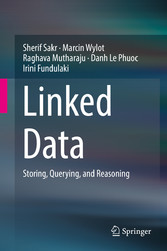Suche
Lesesoftware
Info / Kontakt
Linked Data - Storing, Querying, and Reasoning
von: Sherif Sakr, Marcin Wylot, Raghava Mutharaju, Danh Le Phuoc, Irini Fundulaki
Springer-Verlag, 2018
ISBN: 9783319735153 , 236 Seiten
Format: PDF, Online Lesen
Kopierschutz: Wasserzeichen




Preis: 149,79 EUR
eBook anfordern 
Foreword
6
Preface
8
Organization of the Book
9
Target Audience
10
Acknowledgments
12
Contents
13
About the Authors
16
1 Introduction
18
1.1 Semantic Web
18
1.2 Linked Data
22
1.3 Book Roadmap
24
2 Fundamentals
26
2.1 Linked Data
26
2.2 RDF
29
2.3 SPARQL
33
2.4 OWL
36
2.5 Reasoning
38
2.6 OWL 2 Profiles
42
2.7 Modern Big Data Storage and Processing Systems
43
2.7.1 NoSQL Databases
43
2.7.2 MapReduce/Hadoop
45
2.7.3 Spark
47
3 Centralized RDF Query Processing
50
3.1 RDF Statement Table
50
3.2 Index Permutations for RDF Triples
53
3.3 Property Tables
57
3.4 Vertical Partitioning
59
3.5 Graph-Based Storage
61
3.6 Binary Encoding for RDF Databases
65
4 Distributed RDF Query Processing
67
4.1 NoSQL-Based RDF Systems
67
4.2 Hadoop-Based RDF Systems
71
4.3 Spark-Based RDF Systems
77
4.4 Main Memory-Based Distributed Systems
79
4.5 Other Distributed RDF Systems
82
4.6 Federated RDF Query Processing
90
5 Processing of RDF Stream Data
100
5.1 RDF Streaming Data in A Nutshell
100
5.2 Data Representation of RDF Streams
103
5.3 RDF Streaming Query Model
105
5.3.1 Stream-to-Stream Operator
106
5.3.2 Stream-to-Relation Operator
106
5.3.3 Relation-to-Relation Operator
107
5.4 RDF Streaming Query Languages and Syntax
109
5.5 System Design and Implementation
111
5.5.1 Design
111
5.5.2 Implementation Aspects
113
5.5.2.1 Time Management
113
5.5.2.2 Scheduling and Handling Memory
115
5.5.3 Systems
116
5.5.3.1 Streaming SPARQL
117
5.5.3.2 C-SPARQL
118
5.5.3.3 EP-SPARQL
120
5.5.3.4 SPARQLstream
121
5.5.3.5 CQELS
121
6 Distributed Reasoning of RDF Data
124
6.1 The Process of RDF Reasoning
124
6.2 Peer-to-Peer RDF Reasoning Systems
127
6.3 NoSQL-Based RDF Reasoning Systems
131
6.4 Hadoop-Based RDF Reasoning Systems
132
6.5 Spark-Based RDF Reasoning Systems
135
6.6 Shared Memory RDF Reasoning Systems
137
6.7 Influence on Other Semantic Web Languages
139
7 Benchmarking RDF Query Engines and Instance Matching Systems
142
7.1 Benchmark Definition and Principles
142
7.1.1 Overview
142
7.1.2 Benchmark Development Methodology
144
7.1.3 Choke Points
145
7.2 Benchmarks for RDF Query Engines
147
7.2.1 Real Benchmarks
148
7.2.1.1 UniProt
148
7.2.1.2 YAGO (Yet Another Great Ontology)
149
7.2.1.3 Barton Library
149
7.2.2 Synthetic RDF Benchmarks
152
7.2.2.1 Lehigh University Benchmark (LUBM)
152
7.2.2.2 SP2Bench
154
7.2.2.3 Berlin SPARQL Benchmark (BSBM)
156
7.2.2.4 Semantic Publishing Benchmark (SPB)
161
7.2.3 Benchmark Generators
167
7.2.3.1 DBPedia SPARQL Benchmark (DBSB)
167
7.2.3.2 Waterloo SPARQL Diversity Test Suite
169
7.2.3.3 FEASIBLE
171
7.2.4 Dataset Structuredness
172
7.3 Benchmarks for Instance Matching Systems
174
7.3.1 Datasets
176
7.3.2 Variations
176
7.3.3 Reference Alignment
177
7.3.4 Key Performance Indicators
178
7.3.5 Real Benchmarks
178
7.3.5.1 A-R-S 2009
178
7.3.5.2 Data Interlinking (DI) 2010
180
7.3.5.3 Data Interlinking (DI) 2011
181
7.3.5.4 Overall Evaluation of Real Benchmarks
181
7.3.6 Synthetic Benchmarks for Instance Matching Systems
182
7.3.6.1 IIMB 2009
182
7.3.6.2 IIMB 2010
184
7.3.6.3 Person-Restaurants (PR) 2010
187
7.3.6.4 IIMB 2011
188
7.3.6.5 Sandbox 2012
188
7.3.6.6 IIMB 2012
189
7.3.6.7 RDFT 2013
189
7.3.6.8 ID-REC 2014
190
7.3.6.9 SPIMBench 2015
190
7.3.6.10 ONTOlogy Matching Benchmark with Many Instances (ONTOBI)
191
7.3.7 Overall Evaluation of Synthetic Benchmarks
192
7.4 Instance Matching Benchmark Generators for Linked Data
192
7.4.1 SWING
192
7.4.2 SPIMBENCH
193
7.4.3 LANCE
194
8 Provenance Management for Linked Data
195
8.1 An Overview of Provenance Models
195
8.2 Provenance Representations
197
8.3 Provenance Models
198
8.3.1 Relational Provenance
198
8.3.2 RDF Provenance
199
8.3.3 Update Provenance
202
8.4 Provenance in Data Management Systems
204
9 Conclusions and Outlook
210
9.1 Conclusions
210
9.2 Outlook
213
References
216





